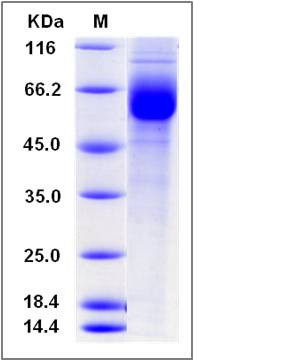Human GPR114 Protein (Fc Tag)
GPR114,PGR27
- 100ug (NPP3906) Please inquiry
| Catalog Number | P10854-H02H |
|---|---|
| Organism Species | Human |
| Host | Human Cells |
| Synonyms | GPR114,PGR27 |
| Molecular Weight | The recombinant human GPR114/Fc is a disulfide-linked homodimer. The reduced monomer comprises 404 amino acids and has a predicted molecular mass of 45.6 kDa. The apparent molecular mass of the protein is approximately 56-63 kDa in SDS-PAGE under reducing conditions. |
| predicted N | Glu 22 |
| SDS-PAGE |  |
| Purity | > 94 % as determined by SDS-PAGE |
| Protein Construction | A DNA sequence encoding the human GPR114 (Q8IZF4) (Met1-Gly184) was expressed, fused with the Fc region of human IgG1 at the C-terminus. |
| Bio-activity | |
| Research Area | Signaling |Signal Transduction |Signaling Pathway |G Protein Signaling |G Protein-Coupled Receptors (GPCRs) |Orphan G Protein-Coupled Receptors | |
| Formulation | Lyophilized from sterile PBS, pH 7.4 1. Normally 5 % - 8 % trehalose and mannitol are added as protectants before lyophilization. Specific concentrations are included in the hardcopy of COA. |
| Background | GPR114 belongs to the G-protein coupled receptor 2 family. Members of this family share a common molecular architecture which consists of seven transmembrane domains, three extracellular loops, three intracellular loops, an amino-terminal extracellular domain and an intracellular carboxyl terminus. It is thought that light acts as the activating stimulus of a G-protein-coupled receptor (GPCR). GPCRs are expected to have molecular function (G-protein coupled receptor activity) and to localize in various compartments (endoplasmic reticulum membrane, plasma membrane, integral to membrane). Family B of the GPCRs is a small but structurally and functionally diverse group of proteins that includes receptors for polypeptide hormones, molecules thought to mediate intercellular interactions at the plasma membrane and a group of Drosophila proteins that regulate stress responses and longevity. GPR114 contains 1 GPS domain. GPR114 gene has been proposed to participate in processes (G-protein coupled receptor protein signaling pathway, neuropeptide signaling pathway). |
| Reference |
